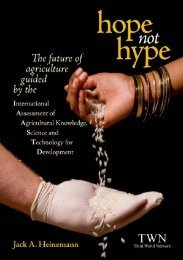gene Flow: Implications for Crop Diversity and Wild Relatives
gene Flow: Implications for Crop Diversity and Wild Relatives
gene Flow: Implications for Crop Diversity and Wild Relatives
- No tags were found...
You also want an ePaper? Increase the reach of your titles
YUMPU automatically turns print PDFs into web optimized ePapers that Google loves.
2.3 In what species or kinds of crops couldtrans<strong>gene</strong> flow occur?Almost all of the world’s most important crop plants are knownto hybridise with wild relatives. At least 44 cultivated cropshave demonstrated the capacity <strong>for</strong> hybridisation with wild <strong>and</strong>weedy relatives, including 12 of the 13 most widely cultivatedcrops (Ellstr<strong>and</strong> et al. 1999), <strong>and</strong> 11 of the 20 most importantUS crops, including sunflower, radish, sorghum, canola, squash,rice, wheat, sugar beet, lettuce, poplar, strawberry, <strong>and</strong> bentgrass(Ellstr<strong>and</strong> 2003). As discussed, <strong>gene</strong> flow to wild relatives <strong>and</strong>l<strong>and</strong>races will depend on the availability of such species nearthe area of cultivation (Messeguer 2003). <strong>Crop</strong>-to-crop <strong>gene</strong>transfer often occurs where transgenic <strong>and</strong> non-transgenic cropsare planted in close proximity. Many of these crop plants areprimarily outcrossing species, including maize, canola (rapeseed),tomato, sorghum, wheat, sugar beet, alfalfa, cucumber, radish,<strong>and</strong> strawberries (NRC 2000).7
















